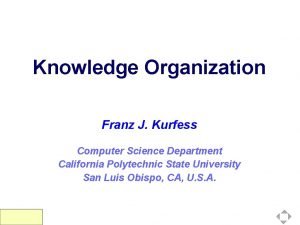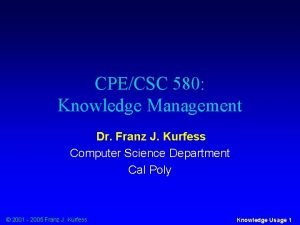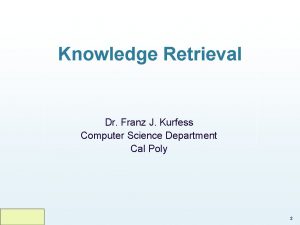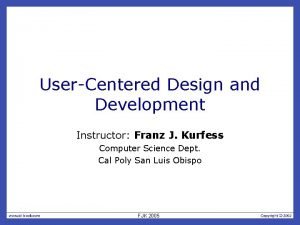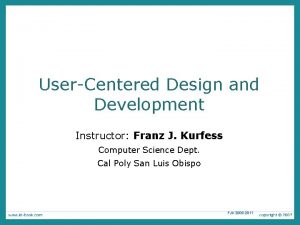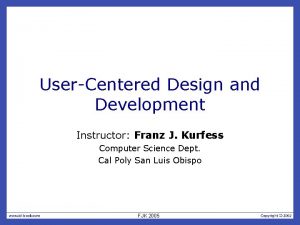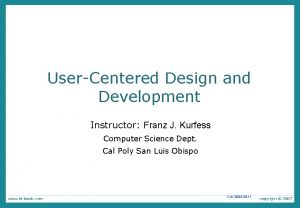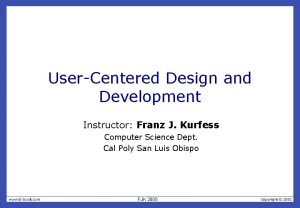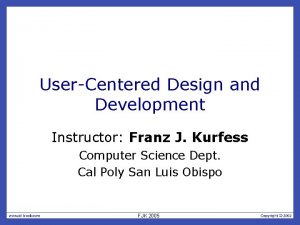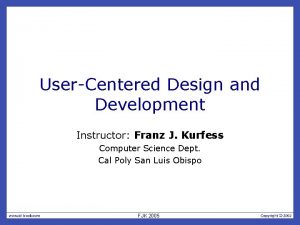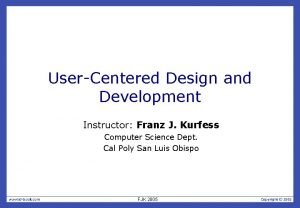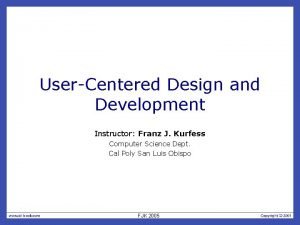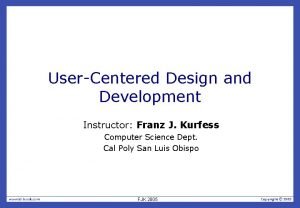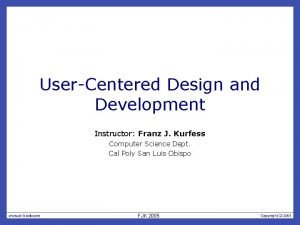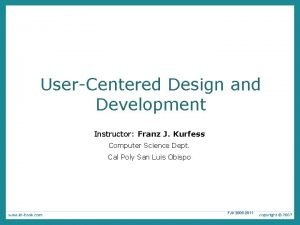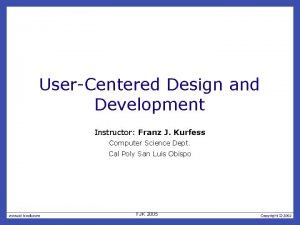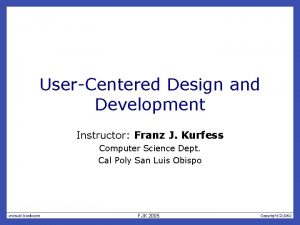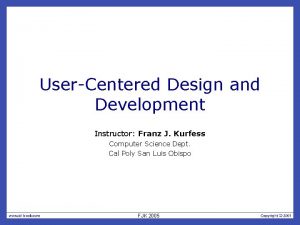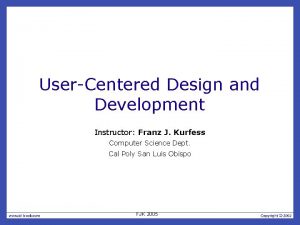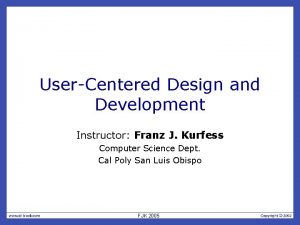UserCentered Design and Development Instructor Franz J Kurfess
































- Slides: 32

User-Centered Design and Development Instructor: Franz J. Kurfess Computer Science Dept. Cal Poly San Luis Obispo FJK 2005

Chapter 13 Asking Users and Experts FJK 2005

Chapter Overview • Asking Users – Interviews – Questionnaires • Asking Experts – Inspections – Walkthroughs FJK 2005

Motivation • often it is easier to talk with users than to observe them • users can present their case, instead of using interpretations and guesses derived from observations • it can be better to talk to experts about the expected behavior of users FJK 2005

Objectives • be familiar with the main methods of asking users and experts • be aware of the differences between various interviewing techniques and types of questionnaires • know how to develop basic interviewing strategies and how to design questionnaires • know when to employ which method • gain experience in obtaining information from users and experts FJK 2005

The aims – Discuss the role of interviews & questionnaires in evaluation. – Teach basic questionnaire design. – Describe how do interviews, heuristic evaluation & walkthroughs. – Describe how to collect, analyze & present data. – Discuss strengths & limitations of these techniques

Interviews • unstructured – not directed by a script – rich but not replicable • structured – tightly scripted, often like a questionnaire – replicable but may lack richness • semi-structured – guided by a script – interesting issues can be explored in more depth – can provide a good balance between richness and replicability

Basics of interviewing • DECIDE framework can offer guidance • goals and questions – guide all interviews • types of questions – ‘closed questions’ have a predetermined answer format, e. g. , ‘yes’ or ‘no’ • quicker to administer • easier to analyze • may miss valuable information – ‘open questions’ do not have a predetermined format • may yield valuable information • may take longer • often more difficult to analyze

Things to avoid when preparing interview questions • long questions • compound sentences – split into two • jargon – language that the interviewee may not understand • leading questions – make assumptions • e. g. , why do/don’t you like …? • unconscious biases – e. g. gender, age stereotypes

Components of an Interview • introduction – introduce yourself, explain the goals of the interview, reassure about the ethical issues, ask to record, present an informed consent form. • warm-up – make first questions easy and non-threatening. • main body – present questions in a logical order • a cool-off period – include a few easy questions to defuse tension at the end • closure – thank interviewee, signal the end (switch recorder off)

Interview Process • • use the DECIDE framework for guidance dress in a similar way to participants check recording equipment in advance devise a system for coding names of participants to preserve confidentiality • be pleasant • ask participants to complete an informed consent form

Probes and Prompts • probes – devices for getting more information – e. g. , ‘Would you like to add anything? ’ • prompts – devices to help interviewee • e. g. help with remembering a name • probing and prompting should not create bias • too much information can encourage participants to try to guess the answer – or the answer they think you would like to hear

Group Interviews • • also known as ‘focus groups’ typically 3 -10 participants can provide a diverse range of opinions need to be managed – – ensure everyone contributes discussion isn’t dominated by one person the agenda of topics is covered stay focused

Analyzing Interview Data • depends on the type of interview • structured interviews – can be analyzed like questionnaires • unstructured interviews – generate data like that from participant observation – analyze as soon as possible to identify topics and themes from the data

Questionnaires • questions can be closed or open – closed questions are easiest to analyze, and may be done by computer • can be administered to large populations – paper, email & the web used for dissemination • electronic questionnaires – data goes into a data base and is easy to analyze – requires computer skills, access • online questionnaires – sampling can be a problem when the size of a population is unknown – may not be representative of the whole group of users

Questionnaire Style • varies according to goal – use the DECIDE framework for guidance • questionnaire format can include: – – – ‘yes’, ‘no’ checkboxes that offer many options (radio buttons) Likert rating scales semantic scales open-ended responses

Likert Scales • have a range of points – 3, 5, 7 & 9 point scales are common – sometimes verbal descriptors are used • debate about which is best

Developing a Questionnaire • Provide a clear statement of purpose & guarantee participants anonymity • Plan questions – if developing a web-based questionnaire, design off-line first • Decide on whether phrases will all be positive, all negative or mixed • Pilot test questions – are the questions clear – is there sufficient space for responses • Decide how data will be analyzed – consult a statistician if necessary

Encouraging a good response • • Make sure purpose of study is clear Promise anonymity Ensure questionnaire is well designed Offer a short version for those who do not have time to complete a long questionnaire If mailed, include a s. a. e. Follow-up with emails, phone calls, letters Provide an incentive 40% response rate is high, 20% is often acceptable

Advantages of online questionnaires • • • responses are usually received quickly no copying and postage costs data can be collected in database for analysis time required for data analysis is reduced errors can be corrected easily

Problems with online questionnaires • Sampling is problematic if population size is unknown – reasonable number of responses – participants may not be representative for the overall populations • self-selected • higher motivation in participating • may have a hidden agenda • Preventing individuals from responding more than once • Individuals have also been known to change questions in email questionnaires – different participants answer different questions

Questionnaire Data Analysis and Presentation • present results clearly – tables may help • simple statistics – can say a lot, e. g. , mean, median, mode, standard deviation – more advanced statistics can be used if needed • percentages – useful but give population size • bar graphs – show categorical data well

Asking Experts • experts use their knowledge of users & technology to review software usability • expert critiques (“crits”) – formal or informal reports • heuristic evaluation – a review guided by a set of heuristics • walkthroughs – stepping through a pre-planned scenario noting potential problems

Heuristic Evaluation • developed by Jacob Nielsen in the early 1990 s • based on heuristics – distilled from an empirical analysis of 249 usability problems • revised for current technology – HOMERUN for the Web • heuristics still needed for new technologies – mobile devices, wearables, virtual worlds, etc. • design guidelines – form a basis for developing heuristics

Nielsen’s Heuristics • • • Visibility of system status Match between system and real world User control and freedom Consistency and standards Help users recognize, diagnose, recover from errors Error prevention Recognition rather than recall Flexibility and efficiency of use Aesthetic and minimalist design Help and documentation

Discount Evaluation • Heuristic evaluation is referred to as discount evaluation when 5 evaluators are used • Empirical evidence: on average 5 evaluators identify 75 -80% of usability problems.

Stages Heuristic Evaluation • briefing session – to tell experts what to do • evaluation period – – duration of 1 -2 hours each expert works separately take one pass to get a feel for the product take a second pass to focus on specific features • debriefing session – experts work together to prioritize problems

Advantages and problems • few ethical and practical issues to consider • can be difficult and expensive to find experts • best experts have knowledge of application domain and users • biggest problems – important problems may get missed – many trivial problems are often identified

Cognitive walkthroughs • focus on ease of learning • designer presents an aspect of the design and usage scenarios • one or more experts walk through the design prototype with the scenario • expert is told the assumptions about user population, context of use, task details • experts are guided by 3 questions – see next slide

Cognitive Walkthrough Questions • Will the correct action be sufficiently evident to the user? • Will the user notice that the correct action is available? • Will the user associate and interpret the response from the action correctly? As the experts work through the scenario they note problems.

Pluralistic Walkthrough • • variation on the cognitive walkthrough theme performed by a carefully managed team panel of experts begins by working separately then there is managed discussion that leads to agreed decisions • the approach lends itself well to participatory design

Key points • structured, unstructured, semi-structured interviews, focus groups and questionnaires – closed questions are easiest to analyze and can be replicated – open questions are richer – check boxes, Likert / semantic scales • expert evaluation: heuristic and walkthroughs – relatively inexpensive because no users – heuristic evaluation relatively easy to learn – may miss key problems and identify false ones
 Franz kurfess
Franz kurfess Franz kurfess
Franz kurfess Stephen kurfess
Stephen kurfess Ned kurfess
Ned kurfess Instructor responsibilities and professionalism
Instructor responsibilities and professionalism The virtual instructor elements of art
The virtual instructor elements of art Lo más importante en la tipología de los participantes
Lo más importante en la tipología de los participantes Basic instructor course texas
Basic instructor course texas Basic instructor course texas
Basic instructor course texas Basic instructor course #1014
Basic instructor course #1014 Pepperball instructor course
Pepperball instructor course Everyone selected to serve on this jury
Everyone selected to serve on this jury Instructor vs teacher
Instructor vs teacher Ospfv
Ospfv Mptc firearms
Mptc firearms Basic instructor course texas
Basic instructor course texas Basic instructor course #1014
Basic instructor course #1014 Nfpa 1403 instructor to student ratio
Nfpa 1403 instructor to student ratio Human factors instructor
Human factors instructor Instructor operating station
Instructor operating station Catia instructor
Catia instructor Instructor
Instructor Tcole 1014 basic instructor course
Tcole 1014 basic instructor course Jrotc marksmanship instructor course online
Jrotc marksmanship instructor course online Nrp instructor toolkit
Nrp instructor toolkit Cisco instructor certification
Cisco instructor certification Wi cbrf registry
Wi cbrf registry Nra certified instructor logo
Nra certified instructor logo Naismith was an instructor of
Naismith was an instructor of Please clean your room
Please clean your room Tcole advanced instructor course
Tcole advanced instructor course Tcole advanced instructor course
Tcole advanced instructor course Jrotc marksmanship instructor course online
Jrotc marksmanship instructor course online
